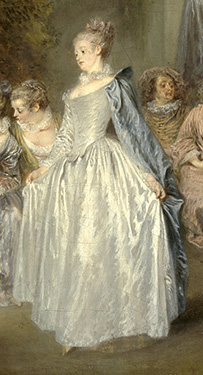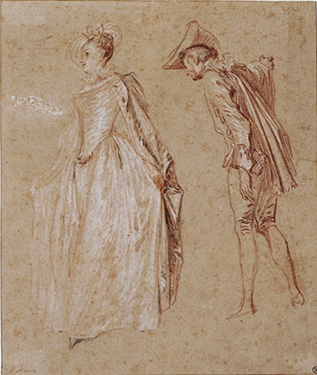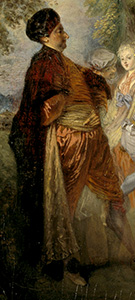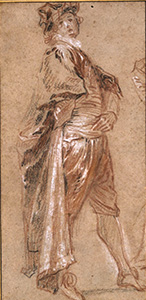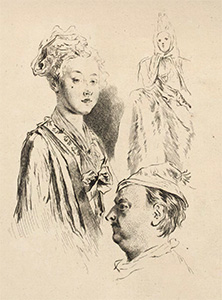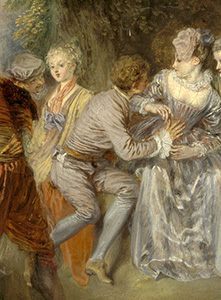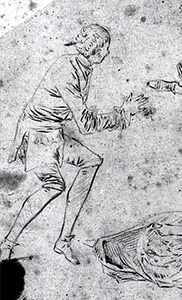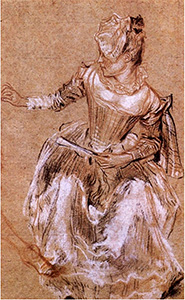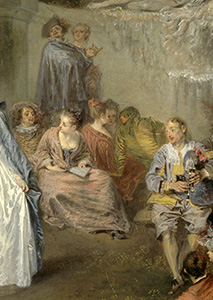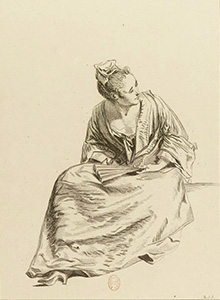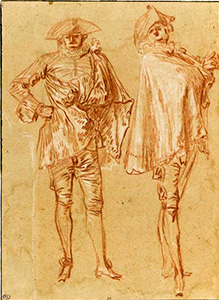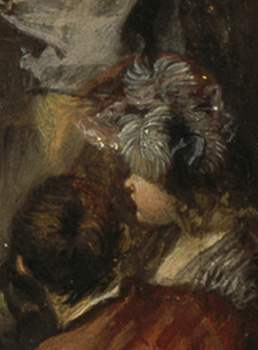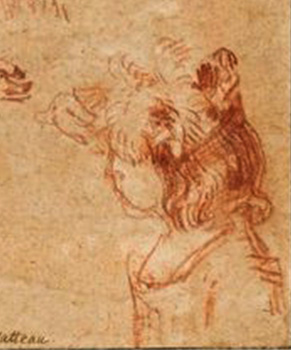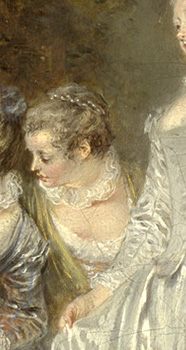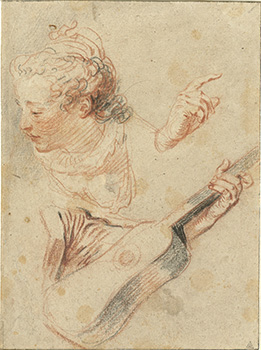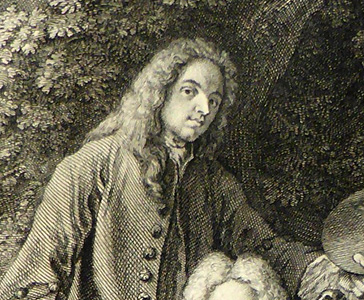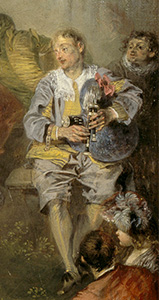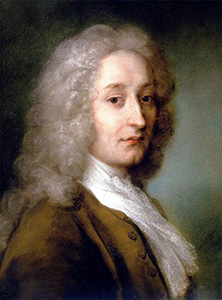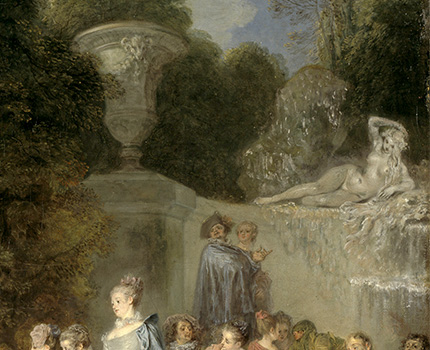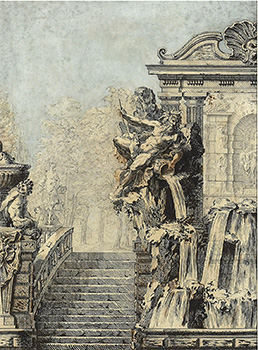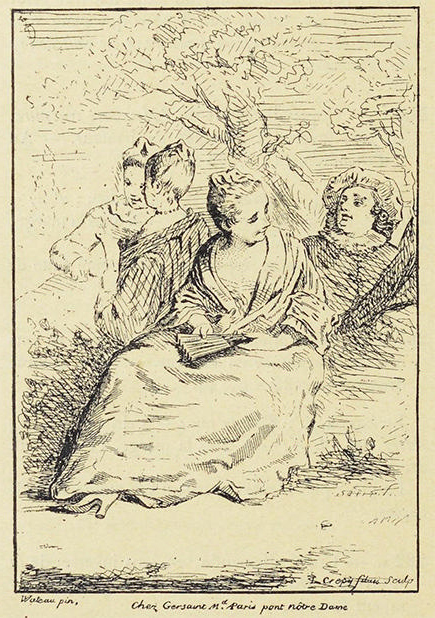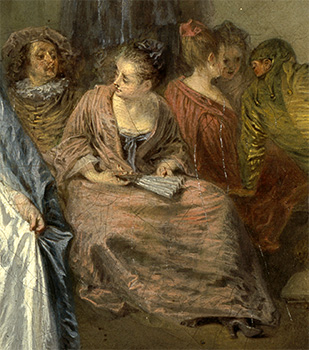
- Home Page
- Accepted
Paintings & Copies - Doubtful
Attributions - Doubtful Textual References
- Alternative
Titles - Collectors &
Museums - Bibliography
- Search Abecedario
- Watteau &
His Circle
Fêtes vénitiennes
Entered February 2023
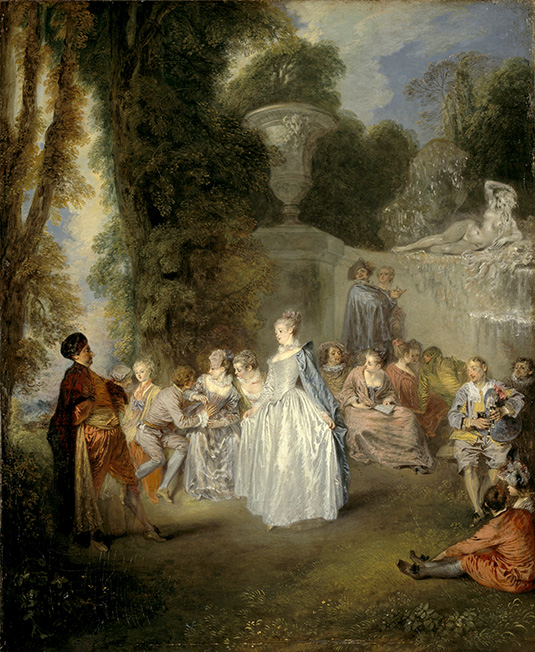
Edinburgh, National Galleries of Scotland, NG 439
Oil on canvas
56.30 x 46.20 cm
ALTERNATIVE TITLES
Bal vénitien
Une Danse
Fête champêtre
Outdoor Gathering with Fountain, Mask-Characters and Pipe Players
Venetian Festivities
Venetian Fêtes
Venetian Parties
Venetian Party
Venetian Pleasures
Venezianischer Feste
RELATED PRINTS
Laurent Cars after Watteau, Fêtes vénitiennes, c. 1732, engraving. 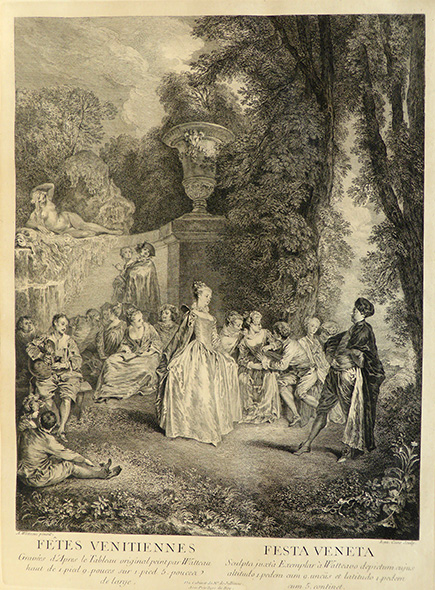
Watteau’s Fêtes vénitiennes was engraved in reverse by Laurent Cars for Jean de Jullienne’s Oeuvre gravé. The print was announced for sale in the July 1732 issue of the Mercure, p. 1609.
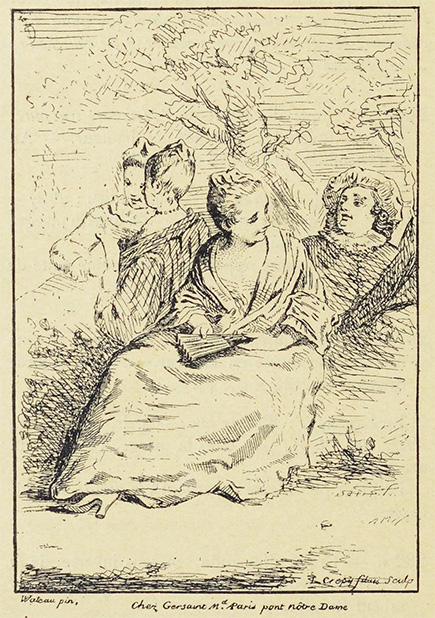
Louis Crépy after Watteau, Galant propos, c. 1731, engraving.
An engraving by Louis Crépy shows two couples engaged in conversation, figures that corresponds to ones right of center, set slightly back, in Fêtes vénitiennes. The inscriptions at the bottom recognize that it copies a Watteau painting (“Wateau pinx.”) and that it was engraved by Crépy (“Crepy filius Sculp.”). At bottom center, the caption reads: “Chez Gersaint Md A Paris pont nôtre Dame.” There is no title, something that would be customary in the Jullienne corpus and, in fact, this print is believed to predate Jullienne’s full-fledged Oeuvre gravé. Apparently the print was issued in a small run, and only a few exemplars have come down to us. When Gersaint’s first wife died in 1725, her estate included the engraving plate and 50 proofs. Today the print is known as Galant propos, but this convention began only in the early twentieth century. The problematic nature of this engraving is discussed in greater detail below.
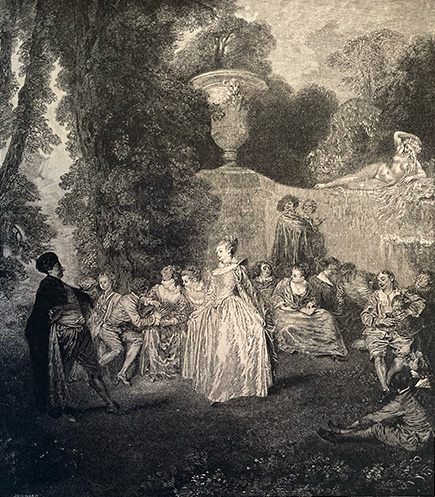
Paul Jonnard after Watteau, Fêtes vénitiennes, c. 1890, engraving.
A wood engraving in the same direction as the painting by Paul Jonnard appeared in the Magazine of Art, 1890, p. 5.
An etching after the picture was reportedly executed by F. Huth.
PROVENANCE
Paris, collection of Jean de Jullienne. Jullienne’s ownership of the painting is specified in the caption to the 1732 engraving: “du Cabinet de M. de Jullienne.” The picture is cited in the manuscript catalogue of Jullienne’s collection, created c. 1756, now in the Morgan Library & Museum, New York.
Paris, sale, March 30f., 1767, collection of Jean de Jullienne, lot 250: “ANTOINE WATTEAU . . . Fêtes Vénitiennes, composées de dix-huit figures dans un paysage, Laurens Cars en a gravé une très belle estampe. Ce morceau est d’un ton de couleur argentine, & touché très spirituellement; les figures sont sveltes & expressives, les teintes conserves dans toute leur fraîcheur, ce qui le rend brilliant & d’un parfait accord; sa distinction est toute particulière. Il est peint sur toile de 20 pouces de haut, sur 17 de large.” Sold for 2,615 livres to Pierre Remy [on behalf of Randon de Boisset].
Paris, collection of Pierre Louis Paul Randon de Boisset (1709-1776; fermier général and receveur général des finances de Lyon). His sale, Paris, February 27-March 25, 1777, lot 178: “Antoine Watteau . . . Fête Vénitienne, composé de dix-huit figures. Ce tableau précieux, tant par son coloris agréable & argentin, que par sa belle conservation, est peint sur une toile de 20 pouces de haut, sur 17 de large; il vient du Cabinet de feu M. de Jullienne. On en trouve une estampe gravée par Laurent Cars.” Sold for 3000 livres to Jean-Baptiste Pierre Lebrun according to annotated copies of the catalogue in the Rijksbureau voor Kunsthistorische Dokumentatie and the Bibliothèque nationale; the annotated copy in the Frick Art Reference Library, New York, records the selling price as 2,999.19 livres.
Paris, collection of Claude Joseph Clos. His sale, Paris, November 18-19, 1812, lot 50: “WATTEAU (Antoine) . . . Fête champêtre, dans un Jardin délicieux, auprès d’une riche fontaine surmontée de la statue d’une Naïade. On y compte dix-huit figures, presques toutes assises sur l’herbe, et causant ensemble, tandis qu’une jeune personne danse le menuet avec son maître, dont la gravité offre un contraste plaisant avec la gaiété et les expressions fines et spirituelles de toutes les autres figures. Ce tableau, d’une conservation parfait, d’un coloris séduisant et argentin, est gravé par Laurent Cars, sous le titre d’une Fête Vénitienne. Il vient du cabinet de M. Randon de Boisset, n. 178 du Catalogue; vendu 3,000 liv.” Sur toile, haut 20 p. et demi, larg. 17 p.” Sold for 399.95 francs to Hippolyte Delaroche.”
Paris, with Hippolyte Delaroche (auctioneer and dealer).
London, collection of Major-General John Ramsay (1775-1842; army officer); by descent to his cousin, Lord Murray of Henderland.
Edinburgh, collection of John Archibald Murray, Lord Henderland (1779-1859). Waagen saw the painting there c. 1854-56. By descent to his wife, Mary Murray née Rigby, Lady Henderland, who donated it to the National Gallery of Scotland in 1861.
EXHIBITIONS
London, Burlington Fine Arts Club. French Art (1914), cat. 8 (as by Watteau, Fête
champêtre, lent by the National Gallery of Scotland).Manchester, French Art Exhibition (1932), cat. 100 (as by Watteau, Venetian Fêtes, lent by the National Gallery of Scotland).
London, Royal Academy, European Masters of the 18th Century (1954), cat. 238 (as by Watteau, Fêtes vénitiennes, lent by the National Gallery of Scotland).
Ottawa, National Gallery, Age of Watteau, Chardin, and Fragonard (2003), 356–57, cat. 9 (as by Watteau, Venetian Pleasures, lent by the National Gallery of Scotland).
Vetter, “ . . . von sanften Tönen” (2005), cat. 1 (as by Watteau, Fêtes vénitiennes (Venezianischer Feste), lent by the National Gallery of Scotland, Edinburgh.
SELECT BIBLIOGRAPHY
Hédouin, “Watteau” (1845), cat. 25.
Hédouin, Mosaïque (1856), cat. 25.
Waagen, Treasures of Art in Great Britain (1854-57), 4: 430.
Waagen, “Notice sur des Tableaux de divers peintres français” (1860), 268.
Goncourt, L’Art au XVIIIème siècle (1860), 57.
Goncourt, Catalogue raisonné (1875), 368, cat. 135.
Armstrong, "National Gallery of Scotland" (1890), 5-6.
Phillips, Antoine Watteau (1895), 72.
Dilke, French Painters (1899), 85.
Zimmermann, Watteau (1912), 177, pl. 47.
Dacier, Vuaflart, and Hérold, Jean de Jullienne et les graveurs (1921-29), 1: 80-81, 188- 89; 2: 50, 57, 79, 97, 121, 130, 158-59; 3: 21, 124, 138, cat. 6, cat. 293 bis.
Bouvy, “Fêtes Vénitiennes,” (1921), 65-82.
Gillet, Un Grand maître (1921), 120-21.
Dacier, La Gravure de genre (1925), cat. 12.
Réau, “Watteau” (1928), cat. 131, cat. 146.
Roux, Fonds français (1930-77), 5: 385-86, cat. 2.
Parker, Drawings of Watteau (1931), 28-29.
Wilenski, French Painting (1931), 111-12.
Barker, Watteau (1939), 79, 166, 196.
Adhémar, Watteau (1950), cat. 197, cat. 199.
Mathey, Watteau, peintures réapparues (1959), 68.
Gauthier, Watteau (1959), pl. 45.
Levey, “The Most Beautiful Picture Watteau Made” (1966), 16.
Brookner, Watteau (1967), 13, 15, pl. 35.
Wildenstein, Inventaires après décès d'artistes (1967), 52, 57, 266.
Macchia and Montagni, L’opera completa di Watteau (1968), cat. 180.
Huyghe, Watteau (1968), 109, 113, 116-17,
Ferré, Watteau, 1972, cat. A34.
Roland Michel, Watteau (1981), cat. 201.
Bryson, Word and Image (1981), 67-68, 101-04, 121.
Roland Michel, Watteau (1984), 52, 60, 171, 223, 229, 266, 299.
Posner, Watteau (1984), 163, 167, 200, 240, 243, 248, 251.
Crow, “Codes of Silence” (1985), 12.
Rosenberg and Prat, Watteau, Catalogue raisonné des dessins (1996), 123, 229, 405, 460, 482, 495, 501, 505, 543, 555, 607, 635, R720, R733, G94, G101.
Walsh, Changing Evaluation of Watteau and His Art (1998), 241-43.
Elkins, Why are Our Pictures Puzzles? (1999), 168-69.
Wintermute, Watteau and His World (1999), under cat. 26.
Minor, Baroque & Rococo (1999), 192-93.
Zeri, Dolcetta, and Mazour, Watteau (2000),16, 28-30, 45, 47.
Temperini, Watteau (2002), 114-15, cat. 96.
Vetter, “ . . . von sanften Tönen” (2005), 9-26.
Michel, Le «célèbre Watteau» (2008), 84-85, 152.
Rousová, Dances and Festivities (2008), 225.
Glorieux, Watteau (2011), 182, 185, 190, 281.
Clarke, A Companion Guide (2012), 118.
Faroult, Vogtherr, and Preti-Hamard, Delicious Decadence (2014), 5.
Edinburgh, National Galleries of Scotland, Botticelli to Braque (2015), cat. 6.
Sund, “Why So Sad?” (2016), 330.
RELATED DRAWINGS
Less than half of the eighteen figures in Fêtes vénitiennes can be traced to Watteau’s extant studies from the model; some are linked only to copies or engravings after no longer extant drawings.
Of those that can be traced, two, fortuitously, are principal characters in the painting—the pair of dancers in the foreground. The elegantly posed woman corresponds to a figure on a sheet of studies now in Weimar (Rosenberg and Prat 495). For the painting Watteau made several slight changes, most notably, tilting her head at an angle. For this, he may have turned to a separate drawing.
The origins of the turbaned dancer at the left are more complex. As can be seen in x-rays and even on the canvas itself, Watteau originally conceived the figure as a slimmer man facing more frontally. For him he turned to a drawing now in the Petit Palais (Rosenberg and Prat 505). At some time after painting that figure he decided to substitute his more corpulent friend, Nicolas Vleughels. To accomplish this he turned to one of his many portrait drawings of his fellow artist, perhaps the one that is recorded in plate 285 of the Figures de différents caractères. In that lost drawing, Vleughels appeared in profile, wearing an artist’s bonnet somewhat like the Oriental turban that he sports in the painting.
It is generally overlooked that the seated man situated beyond the dancer, pursuing his female companion aggressively, was based on a Watteau drawing that is no longer extant but which is recorded in a copy of early Watteau drawings now in Rennes (Rosenberg and Prat R720), and also in one of Quillard’s studies after Watteau. The woman who pulls away from her suitor was based on a forceful trois crayons study in a private New York collection (Rosenberg and Prat 543) but with slight modifications of her right arm. The same figure appears in Watteau’s L’Assemblée dans un parc (Paris, Musée du Louvre).
At the right side of the composition sits a woman with a fan in her lap, attentively watching the dancers. She appears to have been based on a now-lost Watteau drawing that François Boucher engraved for plate 259 of the Figures de différents caractères, though the positions of her legs is slightly modified in the painting. Watteau also used this drawing for his Assemblée galante. Towering above her in the Edinburgh painting is a man with a cloak elegantly thrown over his shoulder. Watteau took this theatrically posed figure from a sheet of two studies of a standing man, now in the Louvre (Rosenberg and Prat 405)
The young girl in the lower right corner of the picture, a feather cockade on her head, was taken from a rich sheet of studies in the Louvre (Rosenberg and Prat 229).
The study of a woman’s head on a sheet in the Rijksmuseum (Rosenberg and Prat 501) may have served for the woman seated to the left of the dancing woman.
Still other drawings have been associated with Fêtes vénitiennes, but less convincingly.
REMARKS
Although modest in scale, Fêtes vénitiennes looms large. Its eighteen figures (sales catalogues in the eighteenth century emphasized their number) are energetic and fill the space allotted to them. The colors are vivid and strong, and, as most scholars are quick to point out, the painting is in fresh and in very good condition. After Waagen saw the painting at some time between 1854 and 1856, he described it as “as an excellent picture, of vigorous and warm colouring, and spiritedly treated.” Yet the painting was once still more intact and beautiful. If one compares it detail by detail with Laurent Cars’ engraving, one finds scattered losses. For example, the engraving shows a crenellated tower in the distant landscape but no such structure is visible in the painting. Also the paint on the turbaned dancer is thin and slightly transparent—perhaps a result of Watteau having repainted the figure. Likewise some details of the subsidiary figures are fuzzy. The painting was cleaned shortly after it entered the museum. Armstrong wrote, "it has been cleaned and now looks cold and raw."
Whereas we can trace the picture’s whereabouts for much of the past three hundred years, its provenance in the late eighteenth and early nineteenth centuries is slightly more problematic than has been recognized. Edmond de Goncourt cited a Paris sale of April 1782 in which the picture was supposedly listed under lot 75. However, it has not been possible to locate such a sale catalogue. Perhaps stymied by the paucity of information—Goncourt failed even to indicate the exact date of the sale—Watteau scholars have not mentioned this sale.
Equally problematic is the painting’s supposed presence in the collection of the famed Scottish portraitist, Allan Ramsay (1713-1784), an assertion frequently made in the past but one that proves baseless. From the painter’s ownership, the picture supposedly passed to his son. This transfer would have had to occur at Ramsay’s death in 1784, but the painting was still in France and not even in the United Kingdom. It still was in France when it sold in Paris in 1812. In short, Allan Ramsay could not have owned it, nor did it pass to his son. The confusion stems from the identity of the member of the Ramsay family who did actually own Watteau’s painting. It was Major-General John Ramsay (1775-1842), an army officer. His cousin was Lord Murray of Henderland, to whom the painting descended after Ramsay’s death. (Similarly, books from Ramsay’s library went to Lord Murray and were sold at auction by Dowells & Lyon of Edinburgh on February 18,1862. Also Waagen enumerated some Ancient statues and artifacts that came from Ramsay’s collection and that then passed to Lord Murray.)
The subject of the painting also needs to be reconsidered. A century ago, Eugène Bouvy noted that the title of this painting corresponded to a ballet of the same name with music by André Campra and libretto by Antoine Danchet. It was first performed at the Opéra in 1710 and was frequently repeated in the following years, thus allowing Watteau sufficient opportunity to have seen it. Almost all subsequent Watteau scholars have repeated this association as though it were a meaningful truth. Yet there is no specific relation between the activities depicted in Watteau’s painting and Campra and Danchet’s ballet. Indeed, there is no causal relationship between the two. On the other hand, they share a commonality in France’s understanding of the city of Venice. For many, the annual Carnival celebration in Venice was emblematic of the city itself: perpetual partying and joviality, music, feasting, and amorous adventures—all accomplished in masked anonymity.
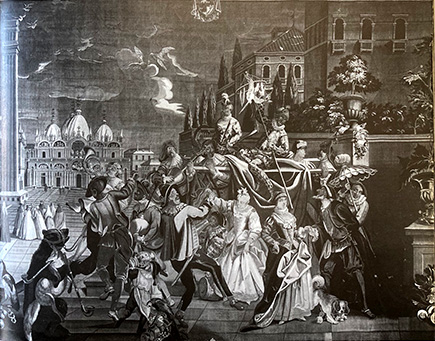
Workshop of André Pirot, Harlequin’s Entry into Venice, c. 1740-45, silk tapestry. Würzburg, Residenzmuseum.
As such, Venice became a popular subject for authors and artists—for men like Campra and Danchet as well as for Watteau. Some treated the theme in a literal way, as in a German tapestry of c. 1740 where in addition to the revelers dressed in commedia dell’arte costumes, the unmistakable façade of St. Mark’s emphasizes that the scene is set in Venice. Watteau's association of his fêtes with Italy was more subtle. Frequently the artist included umbrella pine and cypress trees, as well as Italian buildings–some of them actually identifiable. A bias toward Italy is also emphasized in the titles given in some of the compositions recorded in the Jullienne engravings, such as Recréation italienne.
It has become customary, if not obligatory, for modern critics to point out that the turbaned dancer is a portrait of Watteau’s close friend Nicolas Vleughels, and that the bagpiper is Watteau himself. Yet this is an observation which was not made until a century ago. This idea was not presented in the writings of early Watteau scholars such as Goncourt, Phillips, Josz, or Gillet. Zimmerman recognized the dancer to be Vleughels. The idea that it represented both Vleughels and Watteau was not presented publicly until the 1920s in the writings of Dacier, Vuaflart, and Hérold. Since then it has been echoed by all scholars, and with good reason: the men’s faces do correspond to their other known portraits. Watteau probably did not know Vleughels until after the latter’s return from Italy in the spring of 1715, but after that they were inseparable. Whether the bond was based in their art, their mutual friends in Crozat’s social circle, or perhaps even an amorous attraction, the two men lived in close proximity, first under Crozat’s roof and then in rooms they rented together. They exchanged examples of their art as artists often did; they copied each other’s drawings and incorporated some of these borrowings in their own work.
When he began work on the fête galante now in Edinburgh, Watteau evidently did not plan to include Vleughels’ likeness. As can be seen with the naked eye, he first painted a different man—someone slimmer, his leg bent at the knee, his face turned out to the viewer. But at a later date (how much later?) he overpainted this figure, slightly modifying his stance and, most important, giving him Vleughels’ facial features. Was it then that he decided to insert himself as the bagpiper, playing the music to which his friend dances?
Most attention has focused on the artist’s portrayal of Vleughels but Watteau's characterization of himself is equally fascinating, if not shocking. Unlike the rounded face and thicker, fuller features he painted of himself in his earlier Assis auprès de toy, in Fêtes vénitiennes his face is now considerably thinner. Probably it is the onslaught of the tuberculosis to which he would ultimately succumb. It foreshadows the gaunt face that Rosalba captured in her slightly later rendering of the French artist.
Posner, who took great pains to establish Watteau as an erotic, heterosexual artist, suggested that Watteau painted himself and Vleughels in competition for the female dancer’s attention, an idea which Wintermute seconded. But the visual evidence does not support such a reading. Watteau is set back and behind the woman dancing; he cannot possibly gain her attention. Moreover, there is no historical evidence that either man was attracted to women, much less the same woman, certainly not at this point in their lives.
One of the most striking features in Watteau’s painting is the large fountain that fills the upper right quadrant of the canvas. Its form and sculpted decoration are due to the influence of another of his artist friends—Giles Marie Oppenord. Both men were part of the Franco-Flemish community in Paris, and both received important patronage from Pierre Crozat.
Most modern scholars date Fêtes vénitiennes to the years between 1715 and 1719, which is a reasonable assessment. This accords with Rosenberg and Prat’s dating of between 1715 and 1717 for most of the drawings associated with the picture. Within the last decades there has been a decided shift toward 1717-19. Both Roland Michel and Posner favor 1717-19, while Temperini and the catalogue of the 2003 Ottawa exhibition push toward the upper boundary of 1718-19. This places the painting in the period when the artist was most closely related with Vleughels. Börsch-Supan would date the painting as last as 1720.
As mentioned above, this engraving by Louis Crépy showing two couples engaged in conversation corresponds to figures situated right of center, slightly back, in Fêtes vénitiennes. The engraving is special because it predates Jean de Jullienne’s full-fledged Oeuvre gravé. The inscriptions at the bottom recognize that it copies a Watteau painting (“Wateau pinx.”) and that it was engraved by Crépy (“Crepy filius Sculp.”). Exceptionally, it does not include a title for the painting, something that would become customary in the Jullienne corpus.
It is thought that the print was issued early, c. 1731, before Jullienne embarked on his program to create his extensive corpus of engravings after Watteau’s paintings. Apparently it was issued in a small run since few exemplars have come down to us.
The print has not been mentioned, much less discussed, by most Watteau scholars. Unknown to Hédouin and discovered only at the last minute by Goncourt, it subsequently was bypassed by early scholars such as Zimmerman, Mantz, and Fourcaud. Likewise, it is not cited by recent critics such as Mathey, Brookner, Ferré, Posner, Roland Michel, Rosenber and Prat, Temperini, and Glorieux. Goncourt only became aware of this rare print belatedly, including it in his Additions section, where it is easily overlooked. Adding to the ignomy, no name was attached to the composition when the print was executed, and Goncourt did not apply one. The title Galant propos (Gallant Talk or Conversation) was not introduced until the 1920s, when it was employed by Dacier, Vuaflart, and Hérold, as well as by Réau. Some scholars such as Adhémar use the plural form: Galants popos.
The major question surrounding Galant propos is the identity of the painting it records. Some critics, such as Adhémar, have called it a sketch, but a sketch for what? It is well established that Watteau did not execute painted sketches in preparation for his pictures. Others have thought that Galants propos was a small repetition executed after the artist completed this more complex Fêtes venitiennes. This remains a possibility since, he did this when he modeled his Bon voyage after the Louvre Pèlerinage à l’ile de Cythère. However, no such repetition is recorded in eighteenth- and nineteenth-century sales although, of course, we are handicapped by the lack of a name for this supposed painting.
There is another possible explanation for Crépy’s engraving, one that might seem radical but is compelling. It may be that the engraving was based directly on just the small section of Watteau’s painting with these four figures. Whereas the Jullienne corpus invariably recorded the whole of each Watteau composition, that practice may not yet have been instituted when Crépy made his engraving. Several elements in the engraving point to its direct link with the Edinburgh painting. When executing Galant propos, Crépy masked some of the problems he faced in transcribing Watteau’s painting. For example, the half figure of the man has a tree branch emerging awkwardly from his midsection. Looking back at the painting, we discover that Crépy has taken his lead from the diagonal of the dancer’s arm. Also, the right side of the woman’s skirt, with its strange, uneven ripple, is the vestigial remainder of the dancer’s skirt. A telling giveaway is the man at the left in Crépy’s engraving. This generic figure, whose facial features are not in accord with Watteau’s distinctive style, appears in Fêtes venitiennes but nor distinctly. He is more Crépy’s invention to replace an insufficient model. The liberties that Crépy took are surprising. Shortly thereafter, as Jullienne’s team of engravers began to work in earnest on the Oeuvre gravé, they remained more faithful to their models.
Click here for copies of Fêtes vénitiennes
